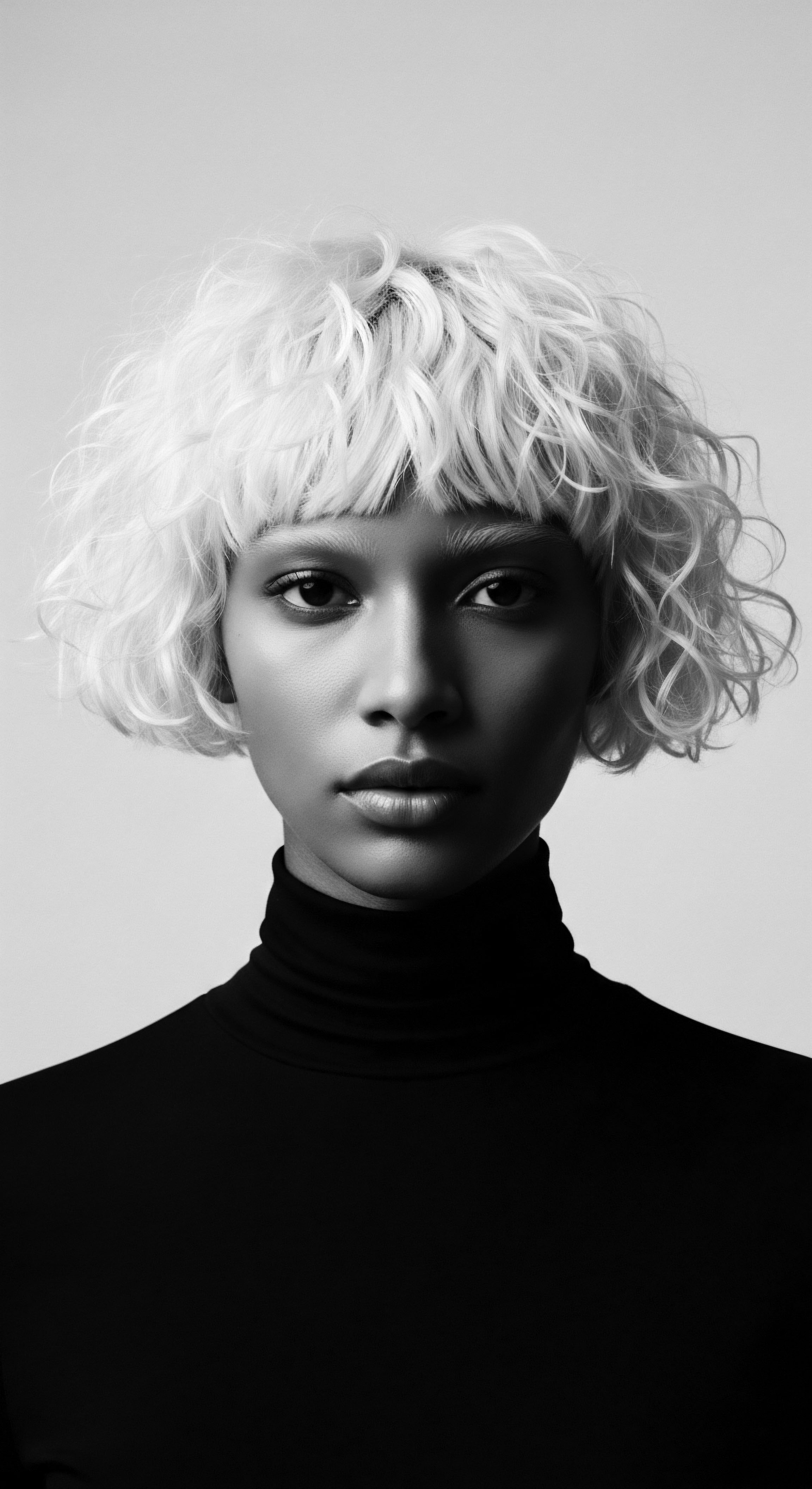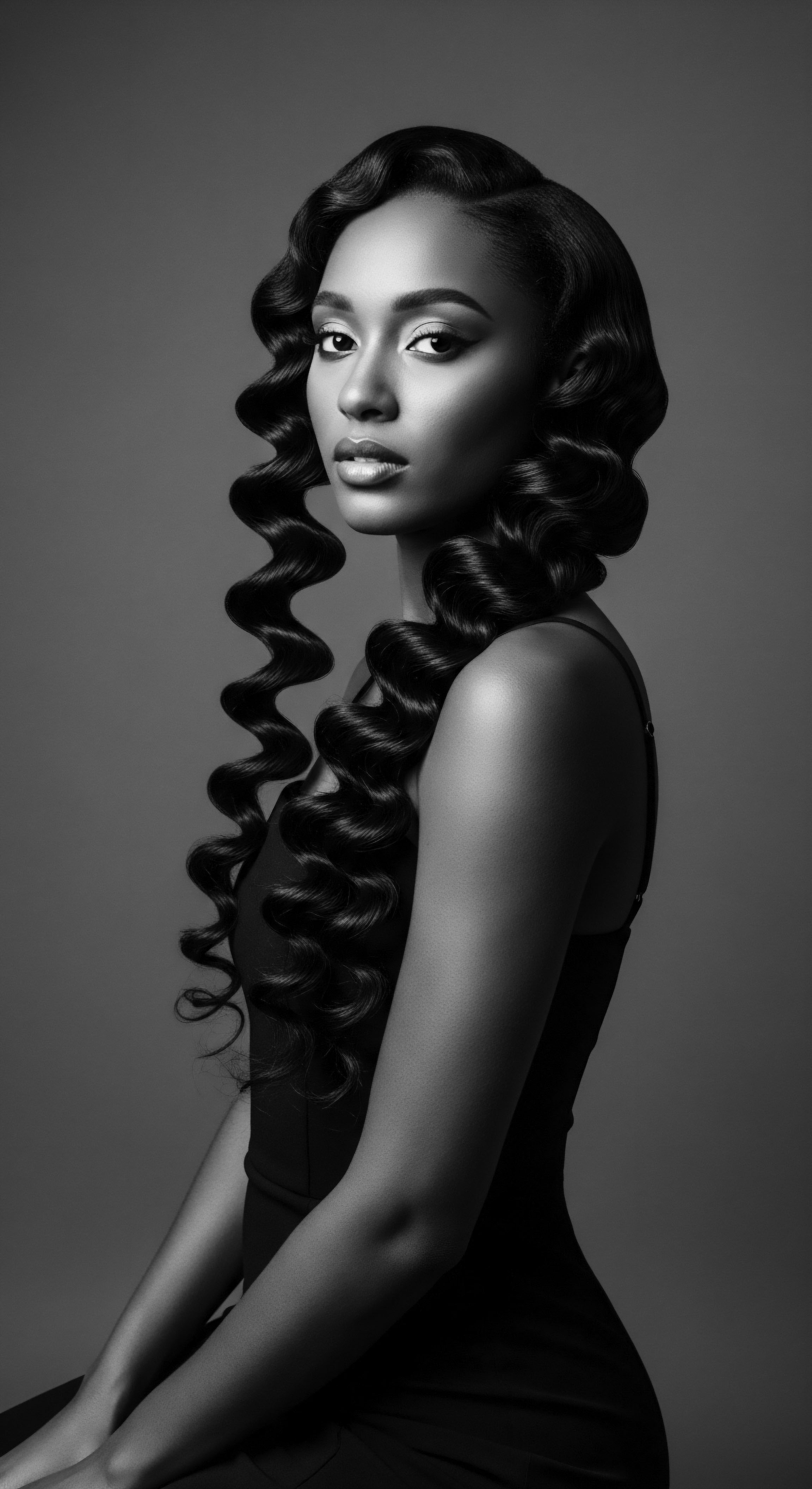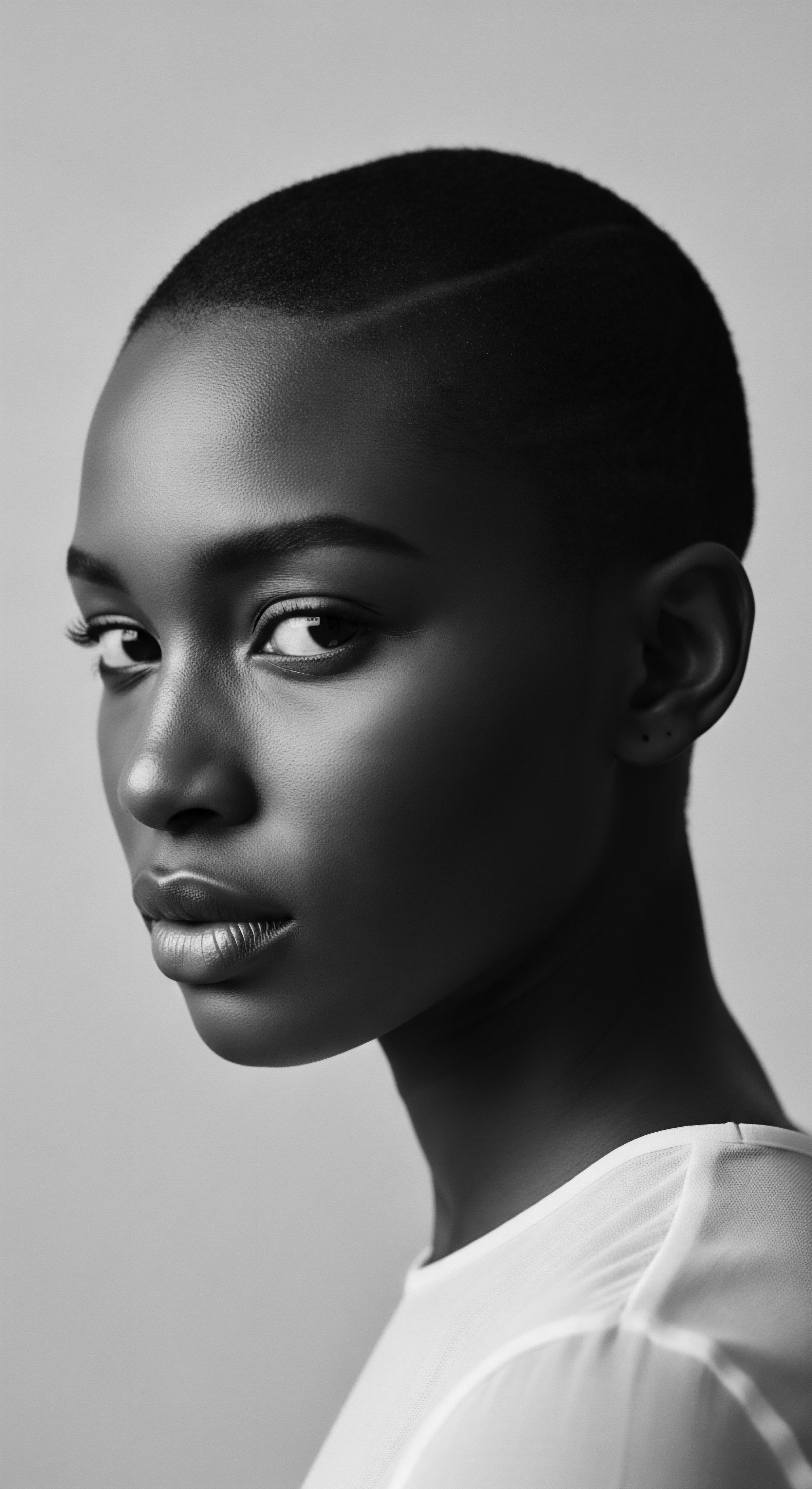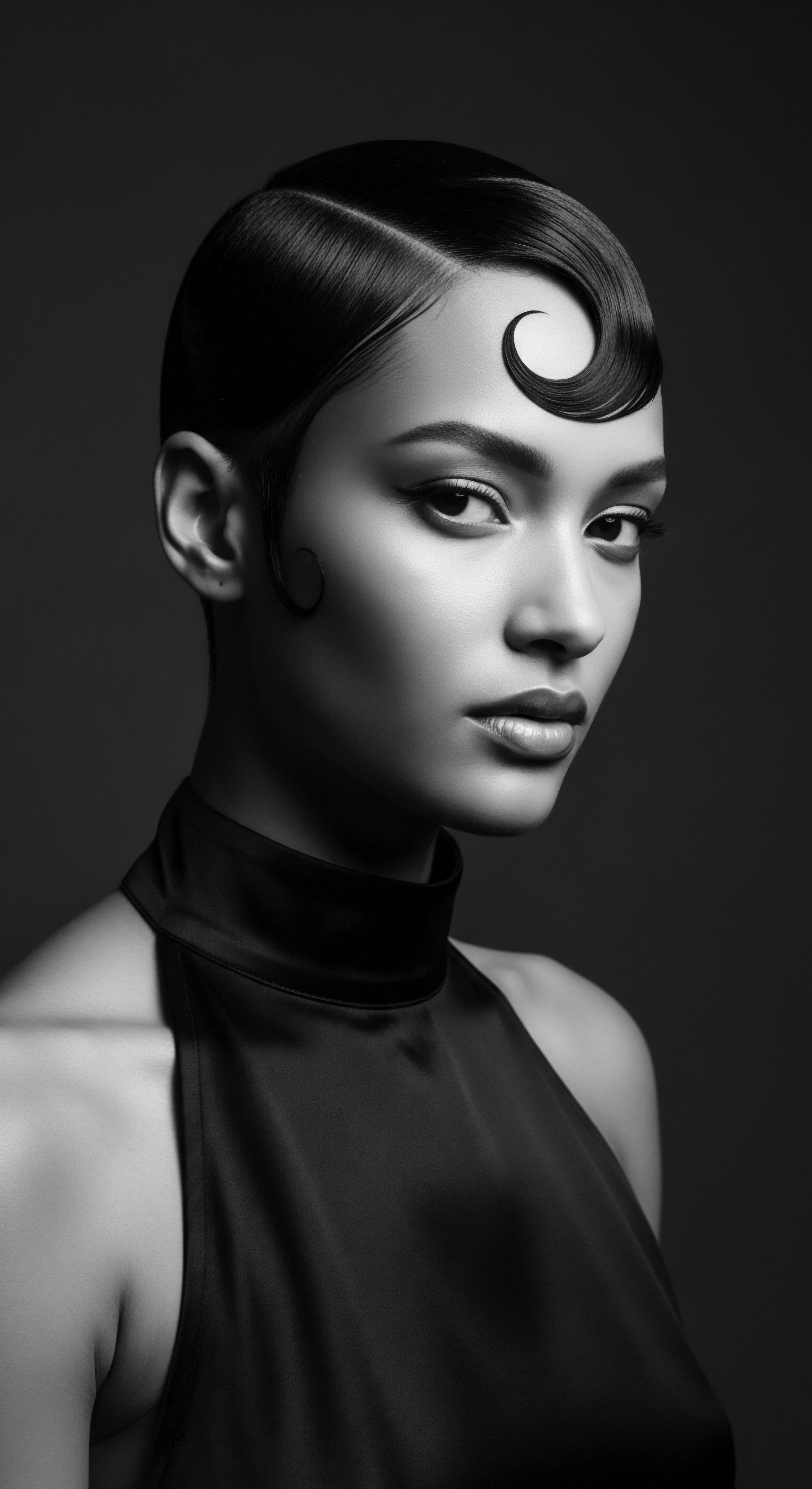
Fundamentals
Chemical treatments, within the expansive realm of hair care, refer to processes that fundamentally alter the natural structure of hair through the application of chemical agents. This definition encompasses a spectrum of services, ranging from hair straightening and relaxing to permanent waving and coloring. These interventions rely on specific chemical reactions to modify the hair’s inherent bonds, resulting in a new, semi-permanent or permanent configuration.
The meaning of ‘chemical treatments’ for textured hair, particularly within Black and mixed-race communities, extends far beyond mere cosmetic adjustments; it intertwines deeply with cultural identity, historical pressures, and the pursuit of specific aesthetic ideals. These processes, at their simplest, involve introducing reactive compounds to the hair shaft, prompting a shift in its molecular blueprint.

Understanding Hair’s Natural Architecture
To grasp the concept of chemical treatments, one must first comprehend the inherent construction of a hair strand. Each individual hair, a delicate thread of keratinized protein, possesses a complex internal arrangement. This structure is primarily defined by various chemical bonds, with disulfide bonds being particularly significant for determining curl pattern. These strong covalent bonds, present in the hair’s cortex, dictate the hair’s natural coil, curl, or wave.
Hydrogen bonds, which are far more fragile, also play a role in hair texture, easily breaking with water or heat and reforming as the hair dries. Chemical treatments directly target these disulfide bonds, making them distinct from temporary styling methods that only affect hydrogen bonds.
Consider a tightly coiled strand of hair, a marvel of natural engineering. Its unique spring-like quality arises from the numerous disulfide bonds formed along the keratin chains. When a chemical relaxer, for example, is applied, it introduces reducing agents that chemically sever these disulfide bonds. Once these bonds are broken, the hair can be reshaped into a straighter form.
Subsequently, an oxidizing agent is often applied to re-establish new disulfide bonds in the hair’s altered, straightened configuration. This intricate dance of chemical reactions permanently modifies the hair’s inherent curl, providing a new stylistic foundation.
Chemical treatments reshape hair’s inherent structure by targeting and altering its internal protein bonds, offering a lasting change to natural texture.

Initial Applications and Their Heritage Resonance
The introduction of chemical straightening products marked a pivotal moment in the history of Black hair care. While early hot combs offered temporary straightening through heat, the advent of chemical relaxers provided a more enduring solution to achieving straightened styles. Garrett A. Morgan, an African American inventor, is credited with creating the first chemical relaxer around 1909, initially discovering the formula while working with sewing machines.
This invention offered a pathway to hair manageability and a distinct aesthetic, resonating deeply within a society that often favored Eurocentric beauty standards. The widespread adoption of these treatments became deeply intertwined with the lived experiences of Black women and men seeking to navigate societal expectations and express their identity.
- Disulfide Bonds ❉ Strong molecular connections within the hair’s cortex that determine its natural curl pattern.
- Hydrogen Bonds ❉ Weaker bonds in hair that are easily influenced by water and heat, allowing for temporary style changes.
- Reducing Agents ❉ Chemicals that break down disulfide bonds, preparing the hair for reshaping.
- Oxidizing Agents ❉ Compounds that reform disulfide bonds in a new configuration, solidifying the altered hair structure.

Intermediate
Venturing beyond the fundamental meaning, the understanding of chemical treatments deepens to encompass their specific typologies, the nuanced chemical processes at play, and their profound impact on the heritage of textured hair. This section clarifies the primary categories of chemical hair alteration and begins to illuminate the complex interplay between chemical composition and historical consequence for Black and mixed-race hair experiences.

Categorizing Chemical Hair Treatments
Chemical treatments for hair are generally categorized by the primary active ingredient and the type of chemical reaction they initiate. For straightening or relaxing textured hair, two dominant families of relaxers have shaped the landscape of hair care:
- Hydroxide Relaxers ❉ Often referred to as “lye” relaxers when they contain Sodium Hydroxide, these are considered among the strongest chemical straightening agents. They are highly alkaline, possessing a pH typically around 13. This potent alkalinity facilitates a process known as lanthionization, which permanently breaks the hair’s disulfide bonds by removing a sulfur atom and forming a new lanthionine bond. The hair fiber swells significantly, becoming amenable to reshaping into a straighter form. Other variations within this category include potassium hydroxide and lithium hydroxide. Due to their strength, precise application and careful timing are paramount to prevent scalp burns and hair damage.
- Ammonium Thioglycolate (Thio) Relaxers ❉ These are commonly known as “thio” relaxers and operate through a different chemical pathway. The active ingredient, ammonium thioglycolate (ATG), acts as a reducing agent that breaks disulfide bonds by adding hydrogen atoms to the sulfur bonds. This process is reversible, unlike lanthionization, and requires a neutralizer (often hydrogen peroxide) to re-form the disulfide bonds in the desired straightened configuration. Thio relaxers are generally considered milder than hydroxide relaxers, making them suitable for hair that requires less intensive straightening or for creating softer waves or curls, as seen in permanent waving. They are often preferred for wavy and curly hair textures.
Beyond these primary categories, “no-lye” relaxers, which contain calcium hydroxide and guanidine carbonate, gained prominence for their perceived gentler action, despite still being highly alkaline. These formulations emerged to offer an alternative to the harshness of lye-based products, though concerns about their drying effects on hair have also arisen. The evolution of these various chemical compositions reflects a continuous effort to balance efficacy with hair and scalp well-being within the beauty industry, a concern that deeply resonates within the textured hair community.

Chemical Treatments and Their Societal Echoes
The pervasive presence of chemical hair straightening treatments in Black communities, especially from the mid-20th century onwards, is a testament to the powerful influence of Eurocentric beauty ideals. Historically, African hair was rich with meaning, symbolizing aspects of social status, tribal affiliation, and even spiritual power. However, the transatlantic slave trade and subsequent colonial influences sought to dismantle these connections, often beginning with the forced shaving of heads upon enslavement as a dehumanizing act. This rupture from ancestral practices initiated a long and complex journey for Black hair, where straightened styles often became a means of perceived assimilation, social acceptance, or even economic survival within dominant societal structures.
Chemical hair treatments, particularly relaxers, have a complex legacy, offering both a path to desired aesthetics and reflecting historical pressures to conform to Eurocentric beauty standards.
The narrative surrounding chemical treatments is not simply one of personal preference; it is also deeply rooted in the broader societal context of beauty and acceptance. Advertising campaigns, particularly between the 1960s and 1970s, frequently showcased Black women with “straight and shiny hair,” perpetuating the idea that such styles were more “beautiful” or “glamorous”. This marketing contributed to an internalized perception that natural, coily hair might be less desirable, prompting many to seek chemical alteration for “manageable” hair.
A 2023 survey revealed that a notable 61% of Black respondents who used chemical straighteners did so because they “felt more beautiful with straight hair.” This statistic, while sobering, underscores the enduring power of external beauty standards and their profound impact on self-perception within the Black community. The pursuit of straightened hair, therefore, was not always a simple aesthetic choice; it often reflected a desire for community belongingness or was a maternal choice for daughters, passed down through generations.
| Historical Period / Event Pre-colonial Africa |
| Impact on Hair Practices (Chemical Treatments & Beyond) Hair served as a rich cultural marker, indicating status, age, marital status, and spiritual connections; intricate braiding and sculpting were common. |
| Historical Period / Event Transatlantic Slave Trade |
| Impact on Hair Practices (Chemical Treatments & Beyond) Forced head shaving and denigration of African hair textures aimed to strip identity, fostering the early emergence of methods to "tame" hair. |
| Historical Period / Event Early 20th Century (Post-Emancipation) |
| Impact on Hair Practices (Chemical Treatments & Beyond) Rise of "hot combs" and chemical relaxers, such as those popularized by Madam C.J. Walker and invented by Garrett A. Morgan, offered greater manageability and allowed for Eurocentric styles amidst societal pressures. |
| Historical Period / Event Mid-20th Century (1960s-1970s) |
| Impact on Hair Practices (Chemical Treatments & Beyond) Chemical relaxers became widely popular; simultaneous emergence of the Black Power Movement championed natural Afros as symbols of pride and resistance. |

Academic
A rigorous examination of chemical treatments transcends superficial definitions, delving into the precise biochemical mechanisms that underpin their action, their complex historical trajectory, and the profound psychosocial implications they carry for individuals of textured hair heritage. This academic exploration, rooted in scientific understanding and cultural scholarship, endeavors to provide a comprehensive interpretation of their meaning and significance.

Biochemical Foundations of Hair Alteration
At its fundamental biochemical level, a chemical treatment, particularly a hair relaxer, systematically disassembles and reassembles the intricate protein architecture of the hair fiber. The primary targets of these treatments are the Disulfide Bonds within the keratin proteins of the hair’s cortex. These strong covalent bonds are responsible for the hair’s structural integrity and its inherent curl or coil pattern.
The two main categories of chemical relaxers, hydroxide-based and thioglycolate-based, operate through distinct, yet equally impactful, chemical reactions:
- Hydroxide Relaxers (Lye and No-Lye Formulations) ❉ These agents, characterized by their extreme alkalinity (often pH 13 or higher), initiate a process known as Lanthionization. The hydroxide ions in these formulations (e.g. sodium hydroxide, lithium hydroxide, potassium hydroxide, or calcium hydroxide in “no-lye” types) react with the disulfide bonds. This reaction causes a sulfur atom to detach from the cysteine amino acid, forming a new, stable lanthionine bond. This molecular rearrangement permanently straightens the hair, as the original disulfide bonds cannot re-form in their coiled configuration. The process is irreversible, meaning the hair’s curl pattern is permanently modified. The significant swelling of the hair fiber during this process renders it highly pliable for reshaping.
- Thioglycolate Relaxers (Thio Relaxers) ❉ These treatments employ ammonium thioglycolate (ATG) as the primary active ingredient. ATG, a reducing agent, breaks the disulfide bonds by adding hydrogen atoms to the sulfur components. Unlike lanthionization, this breakage is reversible. Once the desired level of relaxation is achieved, a neutralizer (typically hydrogen peroxide) is applied. This oxidizing agent re-forms the disulfide bonds in their new, straighter or relaxed configuration. The hair retains some level of texture, and the process is often used for permanent waving as well as relaxing.
The application of these potent chemicals can lead to significant physiological consequences. Scalp burns and lesions are a common occurrence, particularly with hydroxide relaxers, and these Compromises in the skin barrier may allow toxic chemicals to enter the bloodstream. Research indicates that frequent and long-term use of lye-based hair relaxers may elevate the risk of estrogen receptor-positive breast cancer among Black women, with some studies suggesting a 30% increased risk for those using products seven or more times a year for 15+ years.
Furthermore, correlations have been observed between chemical hair straighteners and elevated risks of uterine, endometrial, and ovarian cancers, and uterine fibroids. These findings underscore critical public health concerns, especially given that Black women reportedly use chemical straighteners more frequently and often begin using them at younger ages than other demographic groups.

Historical Context and Sociocultural Manifestations
The enduring meaning and practice of chemical hair treatments within Black and mixed-race communities cannot be divorced from their historical roots in systems of racial oppression and Eurocentric beauty mandates. Prior to European colonization, African hair traditions were diverse and deeply symbolic, often communicating familial lineage, marital status, or social standing. The forced displacement and enslavement of Africans marked a devastating rupture in these traditions, as hair was frequently shaved upon arrival as a tactic of dehumanization.
In the aftermath of slavery, as Black individuals navigated a society that often deemed their natural hair “unprofessional” or “unacceptable,” hair straightening emerged as a complex strategy for survival and assimilation. The introduction of chemical relaxers provided a more permanent alternative to the laborious and often damaging hot comb methods. Madam C.J. Walker, while known for hair growers and pressing oils, helped build a haircare industry that served a community seeking solutions for hair that was often denigrated.
Garrett A. Morgan’s invention of the chemical relaxer in the early 1900s further broadened access to these straightening methods.
The widespread adoption of chemical relaxers became a statistical norm for Black girls and women. This prevalence, however, was not solely a matter of personal choice; it was heavily influenced by pervasive societal pressures and the ingrained notion that straightened hair was synonymous with beauty, professionalism, and social acceptance. A 2023 CROWN Research Study, for instance, reported that 41% of Black women altered their hair from curly to straight for job interviews, and 54% felt they should have straight hair for such occasions.
This highlights a deeply embedded systemic pressure that transcended individual preference, demonstrating how hair became a negotiation point for social mobility and respectability. Byrd and Tharps (2014) articulated this phenomenon, noting that despite the natural hair movement gaining traction, a significant number of Black women continued to opt for chemically straightened hair, reflecting the enduring legacy of these deeply ingrained beauty standards.
The economic dimensions of this phenomenon are equally significant. The Black hair care market is a substantial industry, with Black consumers in the U.S. spending an estimated $473 million annually on hair care products, and spending six times more on hair care than other ethnicities. This substantial spending often reflects a disproportionate reliance on products that historically included chemical straighteners.
The historical imposition of Eurocentric beauty ideals profoundly shaped the adoption of chemical hair treatments in Black communities, transforming hair care into a complex act of negotiation between personal identity and societal pressure.

Shifting Perspectives and Identity Affirmation
While chemical treatments have historically served as a means of conforming to dominant beauty standards, their relationship with identity is dynamic and contested. The natural hair movement, gaining significant momentum from the 1960s and experiencing a resurgence in recent decades, represents a powerful rejection of Eurocentric beauty norms and a celebration of natural Afro-textured hair. This movement has fostered a re-evaluation of the role of chemical treatments, prompting many to transition away from relaxers and embrace their inherent hair texture.
Nevertheless, the journey of hair identity remains deeply personal. Discourses that interpret hair straightening solely as “self-hatred” oversimplify the complex psycho-social impetus behind these choices. As research by Banks (2000) suggests, factors like assimilation, economic security, ease of maintenance, and personal preference all contribute to a Black woman’s decision to straighten her hair. The understanding of chemical treatments, therefore, must acknowledge this multiplicity of motivations, moving beyond reductive assumptions to appreciate the nuanced experiences of individuals.
- Disparate Health Outcomes ❉ Black women face heightened risks of certain cancers and other health issues linked to chemical hair treatments due to higher frequency and earlier initiation of use.
- Economic Influence ❉ The substantial spending power of Black consumers in the hair care market continues to shape product development and marketing, historically including chemical straighteners.
- Identity Negotiation ❉ Hair choices, including the use of chemical treatments, reflect a continuous negotiation of identity within a societal landscape often influenced by racialized beauty standards.

Reflection on the Heritage of Chemical Treatments
The story of chemical treatments in the narrative of textured hair is a profound meditation on adaptation, resilience, and the ever-present dialogue between personal expression and societal expectation. These chemical interventions, whether intended for straightening, waving, or coloring, have etched themselves into the very fabric of Black and mixed-race hair heritage, serving as both a tool for conformity and a testament to enduring creativity. From the elemental biology of the hair strand to the complex sociopolitical currents that have shaped hair choices across generations, this journey invites us to consider the whispers of the past that still resonate in our contemporary hair practices.
Ancestral practices, deeply rooted in the communal rituals of hair care and adorned with symbolic meaning, laid a foundation of honoring one’s crown. The tender thread of these traditions faced profound disruption, yet a spirit of care persisted, adapting to new realities. Chemical treatments, therefore, arrived not in a vacuum, but into a lineage already steeped in the significance of hair, even when that significance was challenged or redefined by external pressures. The journey of these treatments from their initial formulations to their widespread adoption, particularly within diasporic communities, mirrors the enduring human desire to shape one’s appearance, alongside the complex interplay of cultural norms and self-perception.
As we gaze upon the unbound helix of textured hair today, we find a landscape vibrant with choice and self-determination. The natural hair movement has offered a powerful counter-narrative, empowering many to embrace their inherent texture and questioning the historical pressures that once made chemical alteration a default. However, the legacy of chemical treatments remains an indelible part of this heritage, prompting continued conversations about health, beauty, and the ongoing work of defining identity on one’s own terms. This ongoing dialogue reminds us that hair, in all its forms, remains a potent symbol of our histories, our struggles, and our boundless capacity for self-expression.

References
- Byrd, A. D. & Tharps, L. L. (2014). Hair Story ❉ Untangling the Roots of Black Hair in America. St. Martin’s Press.
- Johnson, T. & Bankhead, T. (2014). Hair It Is ❉ Examining the Experiences of Black Women with Natural Hair. Journal of Pan African Studies, 7(4), 86-101.
- Banks, I. (2000). Hair Flair ❉ The History of Black Hair. University Press of Mississippi.
- Mbilishaka, A. & Apugo, K. (2020). My crown and glory ❉ Community, identity, culture, and Black women’s concerns of hair product-related breast cancer risk. Journal of Cancer Education, 35(5), 1011-1020.
- White, A. J. et al. (2022). Use of hair products in relation to uterine leiomyomata in African American women. Environmental Health Perspectives, 130(2), 027003.
- Etemesi, P. (2025). Chemicals of concern in select packaged hair relaxers available on the Kenyan market ❉ an examination of ingredient labels and measurement of pH. Frontiers in Toxicology, 7, 1373575.
- Chang, C-J. et al. (2022). Hair straightening products and uterine cancer risk. Journal of the National Cancer Institute, 114(11), 1436-1440.
- Koval, C. Z. & Rosette, A. S. (2020). The natural hair bias in job recruitment. Social Psychological and Personality Science, 12(5), 741-750.
- Robbins, C. R. (2012). Chemical and Physical Behavior of Human Hair. Springer.
- Byrd, A. D. & Tharps, L. L. (2001). Hair Story ❉ Untangling the Roots of Black Hair in America. St. Martin’s Press.
